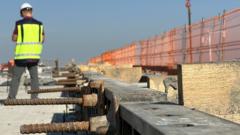The Rail Baltica project represents a critical infrastructure initiative for the Baltic states—Estonia, Latvia, and Lithuania—as they work to secure their positions amid regional geopolitical shifts. Initially envisioned as a high-speed train corridor of 870km (540 miles), Rail Baltica has gained added urgency following Russia's invasion of Ukraine, leading to heightened security concerns about the potential for Russian expansionism in Eastern Europe.
Currently, the Baltic states lack a direct rail link to Poland, which Rail Baltica aims to rectify, significantly shortening travel times and improving economic and environmental conditions. Estonian Infrastructure Minister Vladimir Svet underscored the railway’s significance, equating the current geopolitical landscape to the historical Soviet regime's attempts at territorial control.
The Baltic nations have direct land borders with Russia, alongside significant NATO military presence, with approximately 10,000 allied soldiers stationed there, and a potential ramp-up to 200,000 personnel, highlighting the strategic military importance of the rail link. Rail Baltica is expected to bolster military logistics, facilitating trains from the Netherlands directly to Tallinn—a prospect NATO Commander Peter Nielsen believes is vital.
As construction progresses, the project faces burgeoning costs, now estimated at €24 billion, significantly higher than initial forecasts. The EU has stepped in to fund 85% of the project, contributing an additional €1.1 billion, while local governments grapple with financing the remaining expenses. Criticism mounts over the construction approach, particularly the prioritization of terminal completion ahead of railway infrastructure, igniting debates on regulatory and cultural discrepancies among the three nations.
While Rail Baltica promises extensive economic rewards—projecting a boost of €6.6 billion—authorities are wary of the delays and ongoing challenges presented by rising material costs, a fallout from the COVID-19 pandemic, and the war in Ukraine. Baltic leaders remain determined, with plans to subdivide the project into two phases to manage budgetary limitations and timeline expectations.
The anticipation surrounding Rail Baltica reflects the broader aspirations of the Baltic states to solidify their independence and integration within Europe. As they confront historical memories of Soviet domination, the successful implementation of this railway could symbolize a reinvigorated connection with EU networks and a resilient stance against potential threats from neighboring Russia—if they can remain financially and strategically on course.
















